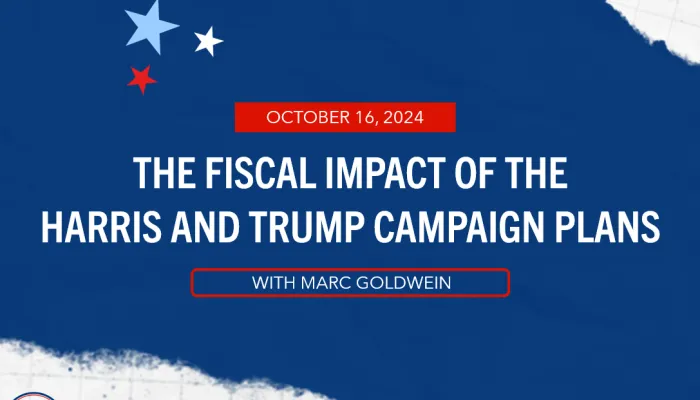Understanding Joe Biden's 2020 Tax Plan
Former Vice President Joe Biden – the presumptive Democratic nominee for President in the 2020 election – has put forward a variety of tax proposals.
Biden would raise the corporate tax rate from 21 to 28 percent, set minimum corporate taxes for domestic and foreign income, restore the top individual tax rate from 37 to 39.6 percent, tax capital gains as ordinary income and at death for very high earners, limit various tax breaks for higher earners, subject wages above $400,000 to the Social Security payroll tax, and pass various other cuts and increases.
Most elements of the plan have been estimated by the Tax Policy Center (TPC), Penn Wharton Budget Model (PWBM), Tax Foundation (TF), and American Enterprise Institute (AEI). We have synthesized these estimates and supplemented them with our own in order to be comprehensive. We find that:
- Vice President Biden’s tax plan would raise between $3.35 trillion and $3.67 trillion over a decade if enacted in full starting in 2021, or 1.3 to 1.4 percent of GDP.
- The Biden tax plan is highly progressive, increasing taxes for the top 1 percent of earners by 13 to 18 percent of after-tax income, while indirectly increasing taxes for most other groups by 0.2 to 0.6 percent.
- The Biden tax plan would moderately slow the pace of economic growth and possibly labor supply by discouraging work and capital accumulation.
- This slower growth would reduce net revenue collection through economic feedback. The plan would raise $2.7 to $3.1 trillion using dynamic scoring.
The ultimate fiscal, economic, and distributional impact of Vice President Biden’s tax policies will depend on how newly raised revenue is spent or allocated. Future US Budget Watch analyses will estimate the effects of tax and spending proposals together in order to provide a holistic picture of Biden’s plans and their potential effects on the budget.
This paper is part of US Budget Watch 2020, a project covering the 2020 presidential election. In the coming weeks and months, we will continue to publish analyses of candidate proposals that are having the greatest impact on the debate over our nation’s future. You can read more of our policy explainers and factchecks here. US Budget Watch 2020 is designed to inform the public and is not intended to express a view for or against any candidate or any specific policy proposal. Candidates’ proposals should be evaluated on a broad array of policy perspectives, including but certainly not limited to their approaches on deficits and debt.
Summarizing the Biden Tax Plan
Vice President Biden has put forward a number of proposals to raise revenue, as well as several proposals to provide targeted tax breaks or make other targeted tax changes. Most, but not all, of these proposals have been estimated by outside estimators.
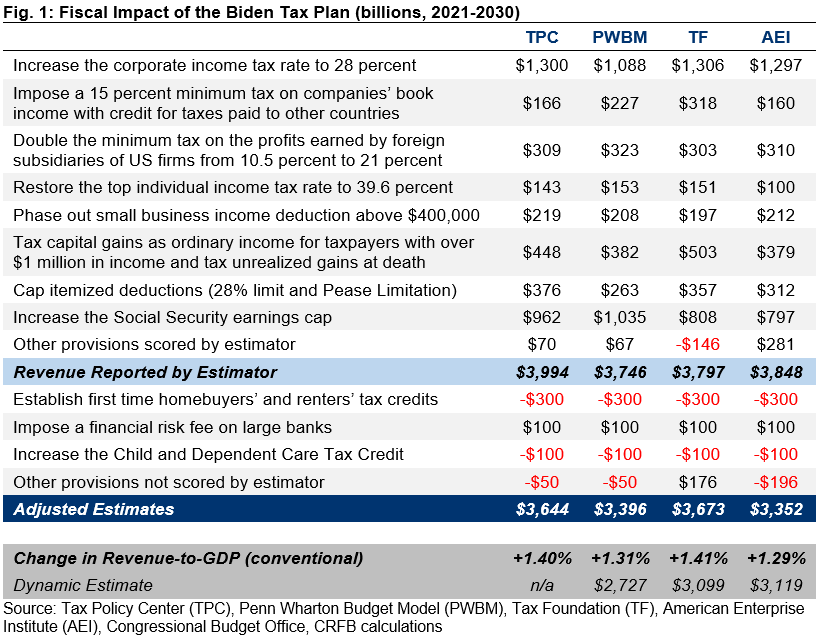
Major proposals by the Biden campaign would raise $1.6 to $1.9 trillion over a decade from corporations, $1.0 to $1.2 trillion from high earners through the income tax, and $800 billion to $1 trillion from Social Security payroll taxes on high-wage earners. Biden also supports a fee on banks, which we believe will raise $100 billion, tax credits for renters and first-time homebuyers that we estimate will cost $300 billion, and an increase of the Child and Dependent Care Tax Credit, which we estimate will cost $100 billion.
Additionally, Biden has included several smaller tax breaks and tax increases throughout his various policy proposals that have a modest net impact. Importantly, our analysis is based on conventional scoring, assumes immediate implementation, and counts refundable tax credit proposals outside of the health care proposal we previously estimated.
Details of the Biden Tax Plan
In total, we have identified 27 distinct tax proposals on Biden’s campaign website. These exclude some health care spending that may technically be structured as tax credits. Of the 27 total policies, we consider eleven to be “major proposals,” including eight scored by all four outside estimators and three that we estimated.
We also discuss, in less detail, the 16 additional proposals, showing outside scores where available and our own estimates when no other estimate exists.
| Increase the Corporate Income Tax Rate to 28 Percent | TPC | PWBM | TF | AEI |
| $1,300 | $1,088 | $1,306 | $1,297 |
Biden would increase the tax rate on corporate income from its current 21 percent to 28 percent. In 2017, the Tax Cuts and Jobs Act (TCJA) reduced the rate from 35 to 21 percent while also eliminating certain corporate deductions and preferences. Lifting the rate to 28 percent would raise $1.1 to $1.3 trillion over a decade.
| Impose 15 Percent Minimum Tax on Book Income | TPC | PWBM | TF | AEI |
| $166 | $227 | $318 | $160 |
In addition to increasing the statutory corporate income tax rate to 28 percent, Biden would institute a 15 percent minimum tax on “book” profits – or reported annual income net of annual expenses – for corporations with at least $100 million in annual income. When calculating this new minimum tax liability, corporations would still be allowed to claim deductions for losses carried forward from previous years and foreign taxes paid.
The tax would function as an alternative minimum tax, replacing one that was in effect until the TCJA. The tax would raise $160 to $320 billion over a decade.
| Double the Minimum Tax on Foreign Income to 21 Percent | TPC | PWBM | TF | AEI |
| $309 | $323 | $303 | $310 |
Under current law, a Global Intangible Low-Taxed Income (GILTI) tax requires multinational companies to pay a tax of at least 10.5 percent on foreign income generated from relatively mobile and intangible assets held abroad such as patents, trademarks, and copyrights. The size of the tax is based on taxing 50 percent of this income at the current 21 percent rate.
Biden would double the GILTI tax from 10.5 to 21 percent. This would presumably be achieved by taxing 75 percent of this income at the new 28 percent tax rate. This policy would raise slightly over $300 billion over a decade.
| Restore the Top Individual Income Tax Rate to 39.6 Percent | TPC | PWBM | TF | AEI |
| $143 | $153 | $151 | $100 |
Under current law, individuals making over $207,000 and couples making over $415,000 face a marginal income tax rate of 35 percent; individuals making over $518,000 and couples making over $622,000 pay a 37 percent top rate. Between 2013 and 2018, and starting in 2026 under current law, the top tax rate was and will be 39.6 percent. Vice President Biden would restore that rate immediately, raising $100 to $150 billion over the next decade, all through 2026.
| Phase Out Business Income Deduction Above $400,000 | TPC | PWBM | TF | AEI |
| $219 | $208 | $197 | $212 |
Under current law, some revenue from pass-through entities – for example, sole proprietorships, partnerships, and S-corporations – is partially deductible against income. Specifically, the TCJA allows business owners to deduct 20 percent of Qualified Business Income (QBI) through the end of 2025. For higher earners, a litany of rules and restrictions tries to limit this income to returns on business investment as opposed to labor.
Biden would maintain the current deduction for those making under $400,000 per year while phasing the deduction out completely for higher earners. This would raise about $200 billion over a decade, mostly through 2026 when the deduction expires.
| Tax Capital Gains as Ordinary Income and at Death for Taxpayers with Over $1 Million in Income | TPC | PWBM | TF | AEI |
| $448 | $382 | $503 | $379 |
Under current law, net income from the sale of assets held longer than a year and related dividends is taxed at a top rate of 20 percent (plus a 3.8 percent surtax), whereas earned income is taxed at a top rate of 37 percent (plus a 3.8 percent payroll tax). Furthermore, when one generation inherits an asset from another, the cost basis of that asset gets “stepped-up” from the cost at the time of purchase to the cost at the time of transfer, meaning that the asset’s appreciated value escapes taxation permanently.
Biden would eliminate the preferential treatment of capital gains and dividends for higher earners. First, capital gains and dividends would be taxed as ordinary income at a rate of 39.6 percent for individuals and couples earning more than $1 million. In addition, Biden would eliminate the stepped-up basis for capital gains at death. The campaign does not specify whether capital gains would be “carried over” – meaning the original basis would still apply – or taxed at death, nor what exceptions or exemptions would apply. All estimators assumed his plan would resemble an Obama-era proposal to tax capital gains at death with exclusions based on size and type of assets – though the campaign has said the plan would not apply below $400,000.
In total, these policies would raise $380 to $500 billion over a decade. These estimates are particularly sensitive to assumptions of how responsive asset sales are to capital gains rates.
| Cap the Value of Itemized Deductions for High Earners | TPC | PWBM | TF | AEI |
| $376 | $263 | $357 | $312 |
Under current law, taxpayers can claim a $24,800 per-couple standard deduction or deduct from their income the combined cost of mortgage interest paid, charitable giving, state and local taxes (up to $10,000), and certain other itemized deductions. While only one-tenth of taxpayers itemize their deductions, more than half of taxpayers in the top income decile do.
Biden’s tax plan would limit these itemized deductions in two ways. First, Biden would institute an overall cap of 28 percent on the rate against which one could take itemized deductions. So, for example, an individual in the (newly restored) 39.6 percent tax bracket would see a 28-cent tax reduction for every dollar spent on charitable giving, rather than 39.6 cents without the cap.
Additionally, Biden would reinstate the “Pease Limitation”, which was suspended through 2025 under the TCJA, for those with income above $400,000. The Pease Limitation effectively reduces the amount one can deduct above a certain threshold. For every dollar of income earned above the threshold, the Pease Limitation reduces the value of itemized deductions by three cents.
Taken together, these provisions would raise $260 to $380 billion over a decade.
| Increase the Social Security Earnings Cap | TPC | PWBM | TF | AEI |
| $962 | $1,035 | $808 | $797 |
Under current law, the Social Security program is funded through a 12.4 percent payroll tax – half paid by employers and half paid by employees – on income up to a certain taxable maximum. That taxable maximum – which is $137,700 in 2020 – increases each year at the rate of wage growth.
Biden would increase revenues into the Social Security program by subjecting wages above $400,000 to this same 12.4 percent payroll tax. In doing so, he would create a “donut hole” in Social Security payroll taxes between the current maximum and $400,000. Over time, that donut hole would close as the current taxable maximum continues to increase with wages, while the $400,000 threshold remains static.
This proposal would raise $800 billion to $1.04 trillion over a decade. It would also raise 1.92 percent of payroll over 75 years, which would close 60 percent of Social Security’s solvency gap.
| Re-Establish and Expand the First Time Homebuyer’s Tax Credit and Create a New Refundable Renter’s Credit | CRFB Estimate |
| -$300 |
As part of his plan for affordable housing, Biden would reinstate and expand a tax credit for first-time homebuyers and establish a new credit for renters.
The First Time Homebuyers’ Tax Credit was originally enacted as a temporary way to bolster the housing market during the Great Recession. The original credit was $7,500 or $8,000, expired after about two years, and was sometimes structured as a loan. Biden’s credit would be $15,000 and permanent.
Biden would also establish a new, refundable tax credit for low-income individuals and families designed to hold rent and utility payments to 30 percent of monthly income. He proposes capping this credit at $5 billion per year, which would likely prevent some people who are eligible from getting the credit.
Though none of the estimators were able to score these provisions, we estimate they would cost roughly $300 billion over a decade.
| Establish a Financial Risk Fee on Large Banks | CRFB Estimate |
| $100 |
Biden would institute a “financial risk fee” on banks, bank holding companies, and non-bank financial institutions with over $50 billion in assets.
While the Biden campaign has not provided additional details on the nature of the fee, it would likely be very similar to the version proposed by the Obama Administration in 2015, which would have levied a 7 basis point fee on the covered liabilities – defined as total assets minus tier 1 capital and FDIC-insured deposits – of U.S. financial firms with over $50 billion in assets.
We assume this proposal would raise $100 billion, though revenue could differ based on design.
| Increase Child and Dependent Care Tax Credit | CRFB Estimate |
| -$100 |
Under current law, parents of children under the age of 13 and individuals who have a disabled dependent living in their household for more than half the year may claim a non-refundable tax credit to partially offset expenses related to caring for those children or dependents. The credit is worth up to 35 percent of up to $3,000 of qualified expenses for one dependent and $6,000 for two or more, phased down to 20 percent for those with higher incomes.
Biden would significantly expand this credit by making it refundable for those with no tax liability, increasing the maximum allowable expenses to $8,000 ($16,000 for multiple dependents), and increasing the reimbursement percentage from 35 percent to 50 percent. This would increase the maximum value of the credit from $2,100 to $8,000. We estimate this proposal would cost roughly $100 billion over a decade.
| Additional Proposals | TPC | PWBM | TF | AEI |
| (CRFB estimate based on modeler's score where available) | $20 | $17 | $30 | $85 |
In addition to the major tax proposals, the Biden campaign proposed another 4 revenue-increasing provisions, 11 revenue-reducing provisions, and 1 revenue-ambiguous provision.
Among the more significant revenue-increasing provisions, Biden would eliminate several tax preferences that currently benefit the real estate industry, such as the $25,000 exemption from passive loss rules for rental losses, accelerated depreciation of rental housing, and deferral of capital gains taxes from like-kind exchanges. He would also eliminate various tax preferences for fossil fuels and end the tax deduction for pharmaceutical advertisement spending.
In terms of revenue-reducing provisions, Biden would institute a tax credit for informal caregivers of up to $5,000. He would reinstate or expand several tax credits designed to reduce carbon emissions, such as deductions for emissions-reducing investments in residential and commercial buildings, the Energy Investment Tax Credit, and credits for the purchase of electric vehicles. He would also promote middle-class retirement savings, including by helping small businesses cover the cost of setting up “automatic 401(k)” plans.
All 16 additional proposals are itemized below. Each estimator scored some but not all of these proposals. By using the average of other estimates or generating our own estimates to fill in the blanks, we believe these proposals could raise between $17 and $85 billion, on net, over a decade.
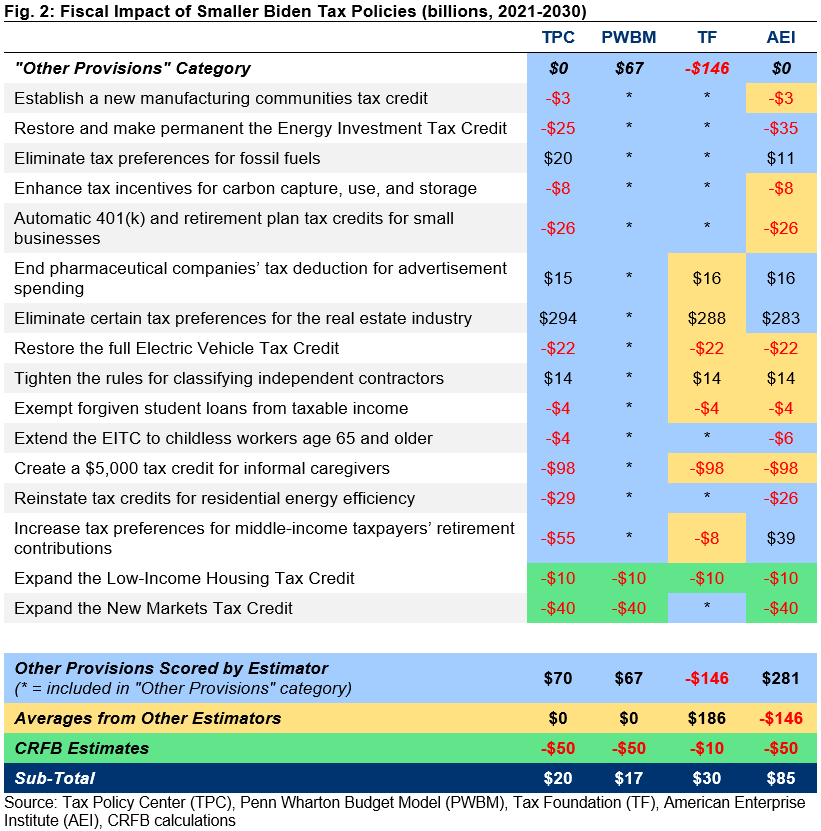
Revenue Impact of the Biden Tax Plan
Four estimators have analyzed Biden’s tax plan in a relatively comprehensive manner. Though they each estimate a slightly different set of proposed policies, they all estimate similar levels of revenue collection. On the low end, PWBM estimates $3.75 trillion of net revenue over ten years, and on the high end, TPC estimates $4.0 trillion of revenue.
Because each analysis excludes some of Biden’s tax proposals, the four estimates are not directly comparable. We adjust the estimates to make them more comparable and comprehensive by adding in missing policies using the average of scores from other estimators or our own estimates.
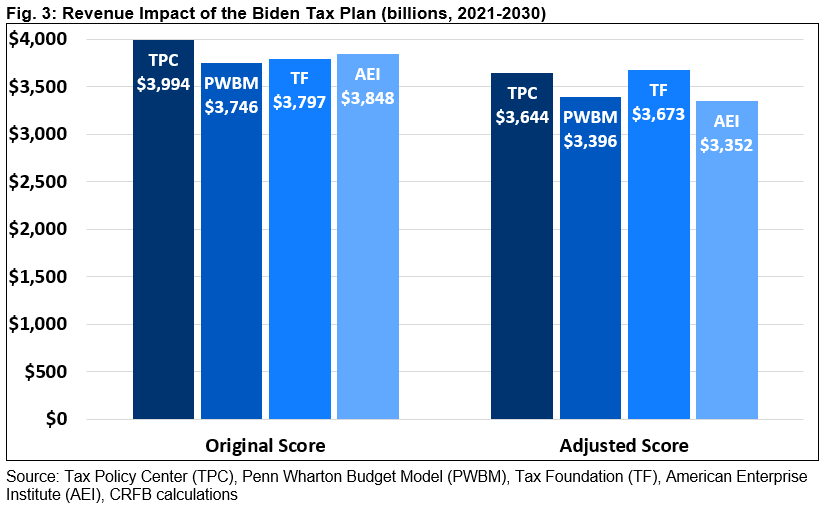
With these adjustments, we find that Biden’s tax plan would increase net revenue by between $3.35 trillion and $3.67 trillion, or 1.3 to 1.4 percent of GDP. This is the equivalent of increasing revenue by almost one-tenth relative to current law.
Incorporating the dynamic economic feedback estimated by three of the four modelers, the Biden tax plan would raise net revenue by $2.7 to $3.1 trillion over a decade, the equivalent of 1 to 1.2 percent of current law GDP.
Distributional Impact of the Biden Tax Plan
Overall, Biden’s tax plan would make the tax code more progressive, with the vast majority of increased tax burdens and the entirety of direct tax increases falling on high-income households. According to the four outside estimators, Biden’s tax plan would increase taxes for the top one-fifth of earners by 2.3 to 5.7 percent of after-tax income in 2021. This increase is driven by a 13.0 to 17.8 percent increase for the top 1 percent.

Meanwhile, those in the bottom four income quintiles will face tax increases of 0.2 to 0.6 percent of after-tax income. These increases are not due to direct taxes – no direct taxes are imposed on any household making less than $400,000 per year – but rather the indirect effects of increasing corporate taxes, which all four estimators assume is partially born by workers.
In dollar terms, the TPC finds households in the top 1 percent will face an average tax increase of roughly $300,000 per year, compared to a $260 per year increase for those in the middle. Other estimators reach slightly different but broadly similar conclusions.
Importantly, none of these distributional analyses account for all of the policies in the Biden tax plan detailed above. Missing elements such as a financial institution fee, credits for renters and first-time homebuyers, and an expansion of the Child and Dependent Care Tax Credit are likely to make the plan slightly more progressive than estimated. The distributional analyses also exclude the effects of Biden's spending proposals, which are largely targeted toward the bottom half of the income spectrum.
Economic Impact of the Biden Tax Plan
Biden’s tax plan would likely modestly shrink the size of the economy over the long term, based on analyses from PWBM, TF, and AEI. They find his plan would reduce incentives to work, save, and invest due to its increases in effective marginal tax rates.
Specifically, AEI estimated the Biden plan would reduce long-run gross domestic product (GDP) by 0.2 percent relative to the baseline, PWBM estimated a 0.7 percent reduction, and TF estimated a 1.5 percent reduction.
PWBM and TF also estimated the labor force would shrink by 0.7 percent (1,000,000 full-time equivalent jobs) and 0.4 percent (600,000 full-time equivalent jobs), respectively. AEI estimates the plan will ultimately increase hours worked by 0.1 percent (100,000 full-time equivalent jobs).
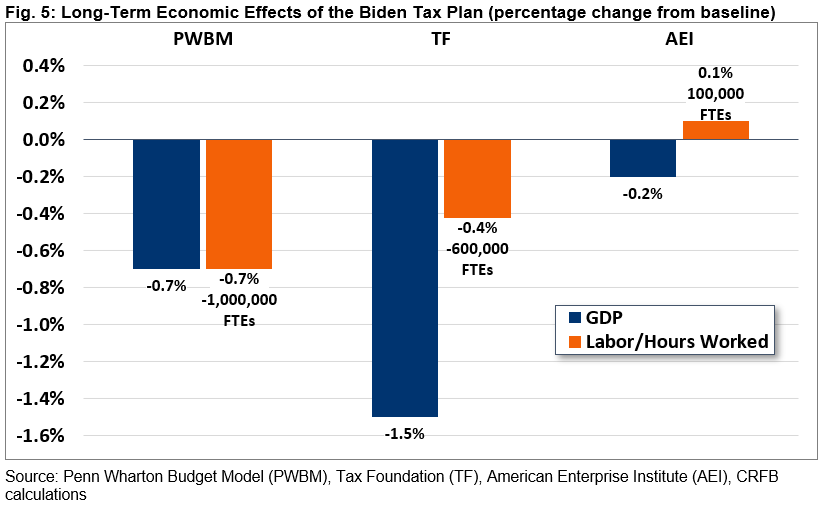
Importantly, these long-run effects are all generated with different modeling assumptions of how deficit reduction might improve the state of the economy. TF essentially ignores deficit effects, whereas AEI and PWBM both use “closing rules” that assume the debt eventually stabilizes on its own, though at different time periods and in different ways.1 None of the estimates incorporate the economic effects of how revenue is spent, which could be positive or negative.
Conclusion
As the presumptive Democratic nominee for President of the United States in the 2020 election, Vice President Biden has put forward a significant tax plan that would substantially increase revenue collected by the federal government over the coming decade. New tax increases would be borne almost entirely by very high-income households and would likely slow the pace of economic growth modestly.
While this revenue would reduce projected deficits and debt in isolation, most or all of the revenue would be used to finance new spending. Without a complete analysis of this spending, it is impossible to understand the full fiscal, economic, and distributional effect of Biden’s agenda.
In the coming months, as we approach the general election in November, we will publish a comprehensive analysis of all of Vice President Biden’s policy proposals and how they compare to President Trump’s.
1 Because of this rule, AEI projects the plan would slow economic growth over the first decade due to higher effective marginal tax rates, accelerate it in the second decade due to deficit reduction, and slow it again over the long-term.
What's Next
-
Image
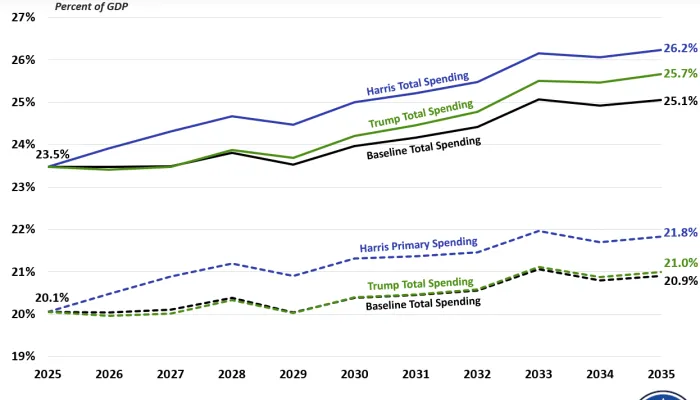
-
Image
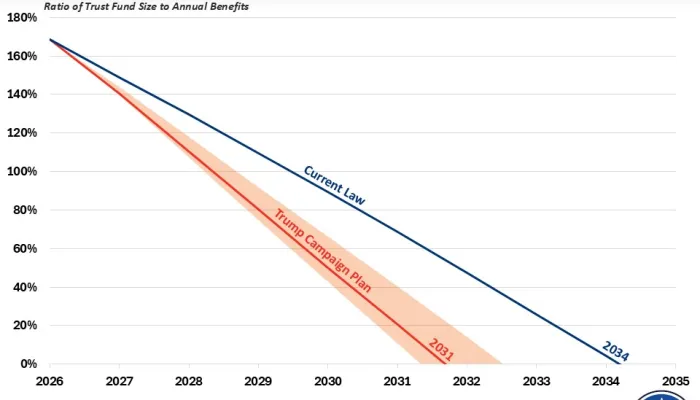
-
Image
